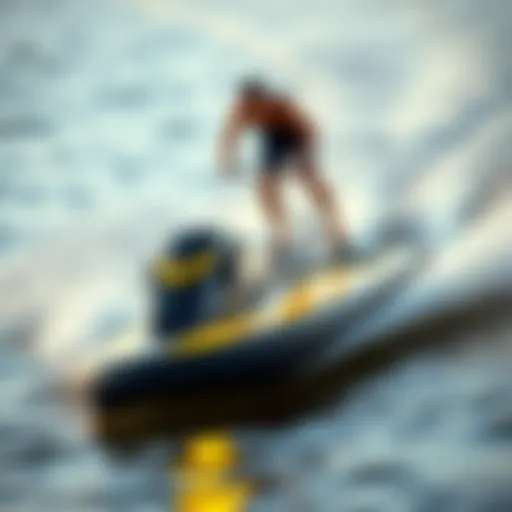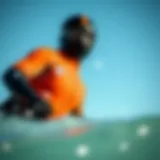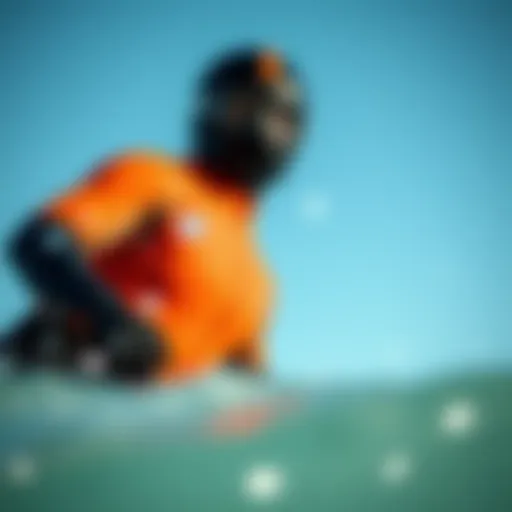Understanding Hydrofoil Pricing in Kiteboarding
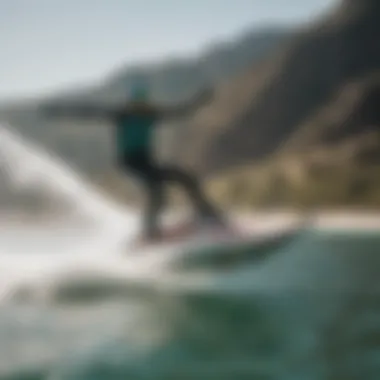

Intro
The influx of hydrofoils into the kiteboarding arena has revolutionized the sport in more ways than one. For those who ride the winds and dance on water, understanding the nuances of hydrofoil pricing becomes crucial. With options galore and various specifications, the cost associated can be a real head-scratcher.
When contemplating a purchase, kiteboarders often grapple with a whirlwind of questions: What makes one hydrofoil worth its weight in gold over another? Are the cheaper options just as reliable, or do they come with hidden pitfalls? This guide aims to sift through the complexities involved in hydrofoil pricing, shedding light on what each price tag represents in terms of performance, durability, and the latest trends in the industry.
Dive deep into this exploration to equip yourself with the knowledge needed to make your next investment in kiteboarding gear. Navigating through these myriad factors not only enhances performance on the water but also ensures you get your money’s worth.
Gear Insights
In the world of kiteboarding, the right equipment can make or break your experience. Hydrofoils, in particular, occupy a unique niche in the gear landscape, marrying advanced engineering with performance.
Latest Gear Reviews
Before embarking on purchasing a hydrofoil, it’s prudent to familiarize yourself with recent reviews and insights. Several brands have launched impressive models that cater to diverse skill levels. For instance, the Liquid Force Rocket wing has garnered attention for its lightweight structure and agility, making it a favorite among many. Meanwhile, the Naish S26 Hover line boasts robust build quality, ideal for those pushing the boundaries of high-performance riding. Reviews often touch upon:
- Construction materials (carbon, aluminum, etc.)
- Performance metrics (speed, stability, maneuverability)
- Suitability for different kiteboarding styles
These factors directly correlate with pricing, so understanding them is key to an informed choice.
Essential Gear for Beginners
For newcomers to the kiteboarding scene, diving headfirst into the hydrofoil pool can seem daunting. It's important to start with gear that balances performance and ease of use. A steady hydrofoil setup such as the Slingshot Flyfoil is noted for its forgiving nature, which aids beginners in mastering their skills without feeling overwhelmed. Key components that every beginner should consider include:
- Size of the hydrofoil: A larger foil often provides more lift but may be harder to control.
- Stability: Look for models that emphasize stability to build confidence.
- Cost-effectiveness: It’s often wise to avoid the most expensive options until skill levels increase.
Finding that sweet spot in pricing while getting the hang of hydrodynamics can pave the way for enjoyable rides ahead.
"Every dollar counts, particularly for those just starting out. Invest wisely, and the surf will come to you."
Techniques and Tips
As you become more acquainted with your hydrofoil, elevating your skills to the next level is both exhilarating and essential. The techniques and tips shared here aim to refine your craft in kiteboarding.
Advanced Tricks and Techniques
Familiarity with your gear opens up a world of tricks that can amp up your time on the water. Riders who have a solid grasp of their hydrofoil often begin experimenting with maneuvers like the downloop or the toe-side jumps. Here's a brief overview:
- Downloops: Engaging the kite in a downloop during a jump can add height and style to your tricks.
- Toe-Side Riding: This technique can be challenging but provides a fresh perspective and can impress onlookers.
Safety Practices for Kiteboarders
While pushing boundaries is thrilling, prioritizing safety can't be overlooked. Always check equipment before hitting the water, mindful of the setup and potential wear and tear. Key safety points include:
- Use of a leash: This helps prevent loss of board or hydrofoil in case of an unexpected wipeout.
- Awareness of surroundings: Keeping an eye out for other kiteboarders, swimmers, and obstacles is key to a safe ride.
Through these insights, kiteboarders can stride forward with confidence in both their purchasing decisions and riding techniques.
Foreword to Hydrofoils
In the realm of kiteboarding, hydrofoils represent a cutting-edge evolution that has captivated the imagination of many enthusiasts and professionals alike. As kiteboarding gains popularity globally, understanding hydrofoils is crucial for anyone looking to improve their riding experience. This section sheds light on the fundamental aspects of hydrofoils, including their definition, functionality, and the remarkable advancements in technology that have shaped their current design.
Definition and Functionality
A hydrofoil can be described as a structure designed to lift a kiteboard out of the water as it gains speed, allowing the rider to glide above the surface. Essentially, hydrofoils are lift-generating wings that minimize drag, enhancing efficiency during rides. When a board is equipped with a hydrofoil, it enables smoother transitions and more exhilarating movements, making it an intriguing option for both seasoned kiteboarders and newcomers.
The functional aspect of hydrofoils involves understanding how they interact with water. Crafting a hydrofoil often entails a delicate balance of various elements: the shape and angle of the wing, size, and the materials used for construction. The effectiveness of lift is determined by Bernoulli's principle and Newton's third law, making hydrofoils an exciting intersection of physics and sport.
The Evolution of Hydrofoil Technology
The narrative surrounding hydrofoils in kiteboarding is not a recent development. It dates back to the mid-20th century when inventors experimented with watercraft designs that harnessed lift. Fast forward to the modern era, today’s hydrofoils have undergone significant transformation, fueled by advancements in material science and engineering.
Initially, hydrofoils were bulky and primarily made of metal, leading to heavier constructions that hampered performance. But as kiteboarding evolved, so did the materials. The shift toward lightweight options, such as carbon fiber, has drastically changed the game, allowing riders to achieve greater heights and speeds.
Moreover, the design has embraced innovation; streamlined shapes and varying wingspans contribute to a more tailored riding experience. For instance, some designs focus on stability and ease of use, while others are engineered for agility and speed. This evolution highlights the idea that the right hydrofoil is more than just a piece of equipment. It's an extension of a rider's ability, catering to specific preferences and riding styles.
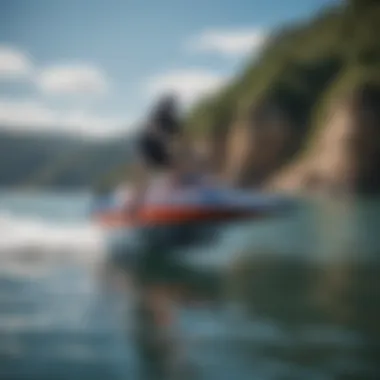

"The advancement of hydrofoil technology illustrates how kiteboarding remains a dynamic sport, continually pushing the boundaries of what's possible on the water."
In summary, comprehending the essence of hydrofoils is an integral part of grasping the broader topic of kiteboarding. As we delve deeper into the specifics of pricing and other factors later in this article, keep in mind that the journey of hydrofoils is one of relentless innovation and inspiration.
Factors Influencing Hydrofoil Price
When it comes to understanding hydrofoil pricing, one must grasp the multitude of variables at play. The price tag attached to a hydrofoil isn't just plucked from thin air; it's a reflection of materials used, design intricacies, brand prestige, and even emerging trends. By dissecting these factors, potential buyers can better navigate the vast ocean of options available and make choices that harmonize with their skill level and riding style.
Material Composition
Carbon Fiber vs. Aluminum
In the realm of hydrofoils, the choice between carbon fiber and aluminum is a significant one. Carbon fiber, with its high strength-to-weight ratio, is like the secret sauce in many high-performance foils. It offers stiffness and responsiveness – qualities essential for those looking to push their limits on the water. On the flip side, aluminum, while heavier and not as rigid, boasts a lower price point which can appeal to novices or budget-minded kiteboarders. Each material comes with its own set of pros and cons.
One can argue that carbon fiber’s lightweight property makes it a firm favorite in the kiteboarding community, facilitating easier maneuvers. However, maintenance of aluminum is generally simpler, often translating to lower costs in the long haul.
Durability and Maintenance Costs
Durability closely ties into material selection. Carbon fiber might withstand the harshest of conditions, yet it's not invincible; sustaining a crack could set a rider back financially. Comparatively, aluminum foils, known for their general fortitude, might become prone to corrosion if not properly cared for. Key here is recognizing that the initial cost is only part of the equation. Long-term maintenance plays a crucial role.
For instance, while carbon fibers may entice with high performance, their repair costs could become burdensome over time. Alternatively, aluminum’s straightforward maintenance could offer peace of mind, albeit at the cost of some performance nuances. Keeping these aspects in mind can help riders make wiser, financially sound choices.
Design Complexity
Wing Shape and Profile
Diving further into design, the wing shape and profile of a hydrofoil are pivotal in determining cost. A hydrofoil’s wing isn't just a slice of material; it’s a finely tuned component that impacts lift and overall handling. The intricacies involved in designing an efficient wing profile translate directly to manufacturing costs.
A well-optimized wing can result in not just better performance but a smoother ride. Aero-dynamic shapes crafted using advanced computational methods often come at a premium. On the other hand, simpler designs, which might not deliver the same level of performance, provide a lower entry point for aspiring kiteboarders.
Manufacturing Processes
Turning our attention to manufacturing, the methods employed can significantly influence pricing. Advanced technologies like CNC machining or injection-molding allow for precise shapes and tailored performance. Such techniques, while enhancing quality and precision, often bear hefty price tags themselves.
Meanwhile, traditional methods may lead to less consistency in quality but can save costs, appealing to budget-conscious enthusiasts. Buyers must consider if quality outweighs price when poring over specifications during the decision-making process.
Brand Reputation
Market Leaders vs. Emerging Brands
Brand reputation plays a crucial role in hydrofoil pricing. Established market leaders often command higher prices due to their history, reliability, and perceived quality. They may provide innovations that appeal to seasoned kiteboarders, fulfilling a specific niche in performance.
Emerging brands, however, can offer attractive alternatives with innovative designs at competitive prices. For a newer rider, this can present an enticing opportunity to obtain high-quality gear without breaking the bank. Yet, one must tread cautiously: newer brands may lack the extensive warranties or customer support found with established ones, which could create later headaches.
Warranty and Support Services
Finally, warranties and support services factor heavily into hydrofoil decisions. A robust warranty signals confidence in the product's durability. This becomes especially relevant in a sport where equipment faces frequent stress and potential damage. In a world filled with choices, knowing that your investment is backed by solid warranty and customer service—like what brands such as Naish or Slingshot offer—adds significant value to the price.
On the contrary, a shorter warranty or inadequate support from lesser-known brands can lead to unexpected surprises and additional costs later on. Buyers should weigh this aspect heavily in their decision-making process, as the peace of mind that comes with comprehensive support may justify a higher price.
Thus, as we dissect these factors, it becomes clear that understanding hydrofoil pricing is not merely an exercise in numbers; it is a thoughtful exploration of quality, performance, and value.
Hydrofoil Price Range
Understanding the price range of hydrofoils in kiteboarding is crucial for anyone looking to invest in this equipment. With various options available on the market, it’s pivotal to grasp where your budget falls within this spectrum. Knowing the price range not only helps you gauge the quality and performance of different models, but it also aids in setting realistic expectations about what you can get for your money.
A well-informed choice can drastically enhance your kiteboarding experience and, with prices varying widely from entry-level to high-end models, this range offers something for every type of rider.
Entry-Level Hydrofoils
Entry-level hydrofoils are specifically designed for beginners. Priced affordably, they generally range from four hundred to eight hundred dollars. These foils might not have the latest technologies like those seen on high-end options, but they serve a critical purpose: making hydrofoiling accessible.
These models are typically made of durable materials such as aluminum or a mix of fiberglass. They are heavier than advanced versions but provide the stability and user-friendliness that new riders need to gain confidence on the water. As a beginner, opting for an entry-level hydrofoil allows you to focus on mastering the basics without breaking the bank.
Mid-Range Options


When you're ready to up your game, mid-range hydrofoils come into play, usually priced between eight hundred to sixteen hundred dollars. This category caters to amateur enthusiasts and intermediate riders who have a bit more experience under their belt and seek improved performance.
Mid-range options often feature better construction materials, like carbon fiber components, which can enhance responsiveness and weight reduction. This means you get more maneuverability without compromising durability. The design might also be more sophisticated, allowing for varying wing shapes that improve rider experience in diverse conditions.
Investing in a mid-range hydrofoil can significantly improve your skills and offers more versatility for different riding styles. Whether you prefer a mellow cruise or a more aggressive approach, these foils adapt better to varying water conditions.
High-End Hydrofoils
High-end hydrofoils usually start at around sixteen hundred dollars and can climb well beyond three thousand dollars, depending on brand prestige and technical advancements. These foils are crafted for serious kiteboarders who demand nothing but the best performance.
Constructed from premium materials like high-grade carbon fiber, these foils are lighter, ensuring faster speeds and more agile handling in aerial maneuvers. Features often include advanced hydrodynamic shapes and high-quality hardware, which enhance both speed and lift.
For competitive riders or those wanting the top-tier equipment, high-end hydrofoils truly deliver. They often come with warranties and customer support that reflect their premium status.
Having a better understanding of these price ranges allows riders to make informed decisions based on their current skill level and future aspirations, ensuring that they get the right gear to match their needs.
In summary, knowing the price range of hydrofoils is more than just about budgeting; it’s about matching your investment to your ambitions in kiteboarding. Whether you're just starting out, looking to enhance your skills, or aiming for top performance, there’s a hydrofoil waiting for you at the right price.
Comparative Analysis of Popular Models
When it comes to kiteboarding with hydrofoils, making the right choice can feel like navigating a maze. Each model on the market claims to offer something unique, yet the nuances often go unnoticed by the untrained eye. This section highlights the importance of comparative analysis, showcasing why a meticulous breakdown of popular models can enhance your decision-making process.
Comparative analysis allows potential buyers to weigh performance characteristics against their specific needs. It’s not just about picking the flashiest option on the shelf; it’s about understanding what features genuinely translate into a better experience on the water. Key factors include design, materials, cost-efficiency, and user feedback.
Engaging with this analysis provides several benefits:
- Informed Decision-Making: Knowing what each model excels at helps kiteboarders choose a foil that meets their expectations, particularly for their skill level and riding style.
- Balanced Perspective: By examining various models side by side, users gain a clearer perspective on value vs. price. Often, a more expensive foil doesn’t mean significantly better performance.
- Optimization of Experience: A proper understanding of different models aids riders in selecting the best hydrofoil to maximize fun and utility based on location, water conditions, and personal preferences.
Performance Characteristics
Delving into the performance characteristics of popular hydrofoils can feel like peeling an onion—layers upon layers revealing greater intricacies. Performance is often influenced by dimensions such as wingspan, aspect ratio, and material construction.
Wingspan of a hydrofoil impacts lift and stability. A longer wing can offer a smoother ride, especially at slower speeds, perfect for beginners looking to gain confidence. On the flip side, shorter wings typically contribute to agility and responsiveness, appealing more to experienced kiteboarders seeking tricks and maneuvers at higher speeds.
Aspect ratio—the relationship between the wingspan and the width—affects the foil’s efficiency. A higher aspect ratio means better lift-to-drag performance, while lower aspect ratios can promote quicker turns, making each model unique in its handling. For example:
- High Aspect Ratio Foils: Excellent for long-distance cruising, offering efficient glides and steady lifts.
- Low Aspect Ratio Foils: Suited for tricks and dynamic moves, allowing fast turns and quick responses.
Meanwhile, material composition plays a pivotal role in performance too. Carbon fiber, while more expensive, can offer a combination of lightweight properties and stiffness, enhancing overall control. Metal options, such as aluminum, may provide durability at lower costs—ideal for newcomers to the sport.
User Experience and Reviews
The beauty of user-generated reviews lies in their raw relatability. They offer firsthand experiences that box store demos simply can’t replicate. Positive reviews often emphasize the nuances of satisfaction that come from reliable performance in actual conditions.
Consider how a rider might describe their interaction with a specific model. They might mention how a particular hydrofoil felt stable during a choppy surf, thus encouraging them to push their boundaries. On platforms like reddit.com, these shared narratives provide wealths of insight, showing potential buyers how popular models fare in real-world conditions.
- Ratings and Comments: Pay attention to recurring themes in user feedback. Common praises and complaints can direct potential buyers toward or away from specific models.
- Versatile Preferences: Different riders favor different characteristics. Some prioritize lift, while others might look for speed. Analyzing these reviews sheds light on what to expect from various hydrofoils.
Ultimately, the goal of a comprehensive comparative analysis is to equip you, as a kiteboarder, with the insights required to find a hydrofoil that will not only resonate with your style but expand your enjoyment on the water. As they say, knowledge is power—especially when it comes to investing in the right gear for the adventures that await.
Emerging Trends in Hydrofoil Pricing
As the kiteboarding scene evolves, so do the trends that influence hydrofoil pricing. Observing these trends is crucial for enthusiasts—their understanding helps in making not just informed purchases but also in anticipating future developments. In today’s fast-paced market, several elements come into focus. Let’s explore the burgeoning trends of sustainability in materials and the integration of smart technology, which are reshaping the hydrofoil landscape.
Sustainability in Materials
Sustainability is now at the forefront of many industries, and kiteboarding is no exception. The environmental impact of products is increasingly scrutinized. Hydrofoil manufacturers are starting to recognize the demand for sustainable materials. Many brands are prioritizing resource-efficient manufacturing processes to minimize waste.
- Recycled Materials: Some companies are incorporating recycled plastics and composites into their builds. The use of materials like these not only reduces dependency on virgin resources but also helps in lowering the overall carbon footprint of the product.
- Bio-composite Alternatives: Aside from recycled materials, advancements are being made in bio-composites made from natural fibers. These alternatives can offer comparable performance without the environmental implications associated with traditional carbon-fiber materials.
Being mindful of the planet can come with a price, however. Sustainable options can be pricier, but many believe that paying a bit more is worth it for the greater good. As conscious consumerism becomes more prominent, the hydrofoil pricing will likely reflect some of these factors.
"When sustainability meets performance, you get a winning formula for the new generation of kiteboarders who care about the world as much as the wind."
Smart Technology Integration
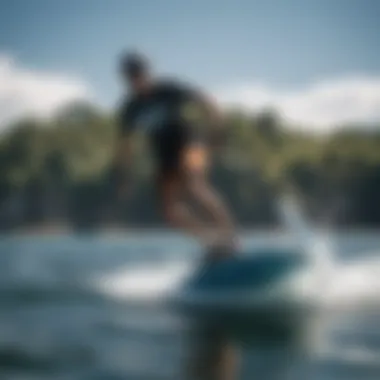

Another captivating trend is the increasing integration of smart technologies into hydrofoils. As kiteboarding progresses into a more tech-savvy era, manufacturers are incorporating electronic features that improve performance and safety.
- Performance Tracking: Some advanced hydrofoils feature built-in sensors that allow riders to track their speed, height, and other metrics in real-time. Such data can be invaluable for those looking to improve their skills or simply enjoy their rides more thoroughly.
- Safety Features: Smart technology, like GPS and collision detection systems, is making its way into hydrofoils as well. Systems that provide real-time updates on wind conditions or detect potential dangers can vastly improve safety, especially for adventurers in unfamiliar waters.
Though these innovations often come with a higher price tag, many kiteboarders view them as worthwhile investments. As technology becomes more ubiquitous, it is likely that the price of hydrofoils will continue to rise with the inclusion of smart features, creating a market where tech-savvy products command premium prices.
Buying Considerations
When diving into the world of kiteboarding, selecting the right hydrofoil can feel like navigating through a maze. This section emphasizes the importance of buying considerations, which can make the difference between a satisfying riding experience and a frustrating one. The choices here have implications on your enjoyment, safety, and even progress in the sport.
Assessing Your Skill Level
In kiteboarding, there's no one-size-fits-all solution when it comes to hydrofoils. Your skill level plays a pivotal role in determining the right equipment. If you’re just starting, it might be prudent to go for something more forgiving and user-friendly. An entry-level hydrofoil—like the Slingshot Hover Glide—is crafted with stability in mind, aiding novices to gain confidence without overwhelming them.
Conversely, if you're a seasoned rider, you might seek a more performance-oriented hydrofoil that allows you to push your limits. High-end options often feature advanced materials and refined designs that can significantly improve lift and handling. It would be beneficial to assess past experiences—your comfort with conditions, how you handle board control, and your goals in the sport. Do you want to ride fast or perform trick maneuvers? Knowing this can help narrow down choices.
Choosing Based on Riding Style
Choosing based on your riding style is myt important. There are distinct riding styles that ask for specific hydrofoil characteristics. Depending on whether you enjoy freestyling, cruising, or racing, different features will appeal to you.
- Freestyling: Riders often prefer short wings that enhance agility, allowing sharper turns and tricks.
- Cruising: Long, stable wings provide smoother rides, especially in varied conditions. They help maintain lift at lower speeds, facilitating a more relaxing experience on the water.
- Racing: High-aspect wings are typically favored here for their speed and efficiency.
When thinking about position in the water, a rider’s weight also matters. A heavier rider might look for a hydrofoil that offers more lift and control. Conversely, lighter riders may choose something with more maneuverability. Regardless of your preference, think about how the hydrofoil’s dynamics align with the style you want to pursue.
Remember: It's always best to test out different models when possible. Renting or borrowing can help you find the right match.
This section on buying considerations sets the stage for careful and informed purchasing decisions, ensuring you invest in gear that aligns with both your current and future kiteboarding ambitions.
Maintenance and Longevity
Understanding the maintenance and longevity of hydrofoils is crucial for every kiteboarder wishing to make the most of their investment. Sure, a high-performance hydrofoil might seem like a hefty purchase at the outset, but neglecting its upkeep can lead to unexpected costs and diminished performance. A well-maintained hydrofoil not only stretches its life but also ensures enhanced functionality on the water.
Routine Care Guidelines
Caring for a hydrofoil is not just about aesthetics; it's a matter of safety and performance. Regular maintenance should involve a straightforward routine that kiteboarders can easily adopt.
Here are some key practices to keep your hydrofoil in top condition:
- Rinsing After Use: Saltwater can wreak havoc on materials over time. After each session, rinsing your foil with fresh water helps remove salt and debris, significantly prolonging its lifespan.
- Inspecting for Damage: Before and after use, it's wise to glance over your hydrofoil for any signs of wear, cracks, or dents. Catching these issues before they escalate can save you headaches down the line.
- Securing Components: Regularly check screws, bolts, and the wing attachment. Make sure nothing is loose. If you hear any unusual sounds while riding, it might be a good idea to take a closer look.
- Storage Practices: When you’re not using your foil, store it in a cool, dry place. Avoid leaving it in direct sunlight or extreme conditions, as these can cause unwanted deformation or damage.
By adhering to these simple yet effective guidelines, kiteboarders can mitigate wear and tear, ensuring that their hydrofoil remains a reliable partner in the waves.
Common Repairs and Troubleshooting
Even with diligent care, some issues may arise. Knowing how to handle common repairs can save time and money and could even keep you out on the water longer. Here are a few typical problems you might encounter along with their solutions:
- Dents and Dings: If you happen to hit an obstacle or land too hard, small dents may appear on your foil. Use a heat gun carefully to warm the area and gently pull out the dent with a suction cup. For deeper dings, you may need to apply epoxy resin for a smooth finish.
- Delamination: If you notice separation in layers, this is quite serious. Clean the area thoroughly and apply a strong adhesive specifically designed for marine applications. In some cases, it may be best to consult a professional.
- Wing Misalignment: If your hydrofoil seems off during rides, check the alignment of the wings. Adjust accordingly. Regularly assessing this alignment helps maintain stability and enhances maneuverability.
"An ounce of prevention is worth a pound of cure."
Kiteboarders should keep this in mind while caring for their hydrofoils. Regular checks and timely repairs can lead to significant savings in the long run. As they say, treat your gear right, and it’ll treat you right back, allowing you to carve through those waves with confidence.
End
Concluding an article on the pricing of hydrofoils in the kiteboarding realm isn’t about simply wrapping things up. Instead, it’s crucial to underscore the significance of understanding this niche market. By grasping what makes hydrofoils tick in terms of cost and performance, kiteboarders can navigate through often muddy waters with a clearer vision.
Recap of Key Insights
As we've dissected throughout this article, several pivotal elements emerge when considering hydrofoil pricing:
- Material Matters: The choice between carbon fiber and aluminum doesn’t just influence the weight of the board but impacts durability and upkeep expenses as well.
- Design Complexity: The intricacies involved in wing shape and profile carry weight—literally and figuratively—on performance and price.
- Brand Reputation: A well-known brand might come at a premium, but often, that comes with quality assurance, warranties, and customer support that newer brands may not provide.
Understanding these nuances lends a keen edge when you're at the shop or shopping online. The landscape of hydrofoil pricing is as varied as the conditions in which they're used, and knowing these insights can prevent costly mistakes.
"Investing in the right hydrofoil can often be the difference between floating gracefully above the waves and wrestling against the currents."
Final Thoughts on Investment
Reflecting on your investment in a hydrofoil goes beyond just the sticker price. Consider this: every hydrofoil is a gateway to improved performance and a deeper connection with the ocean’s rhythm. Before making a purchase, take the time to assess how each option aligns with your riding style, skill level, and future aspirations in kiteboarding.
What might seem like a high upfront cost could lead to years of thrilling sessions, increased skills, and unforgettable memories on the water. If you spot a hydrofoil that speaks to you in both capability and style, it might just be worth that extra penny. Avoid settling for less with a short-term mindset; instead, imagine the experiences that are just waiting to unfold with the right gear beneath your feet.
In the grand scheme, a thoughtful investment in the right hydrofoil can elevate your kiteboarding game, ensuring that each ride is not just another outing but a transformative experience. By embracing the nuances of pricing, you equip yourself to tackle the waves ahead with confidence and agility.

